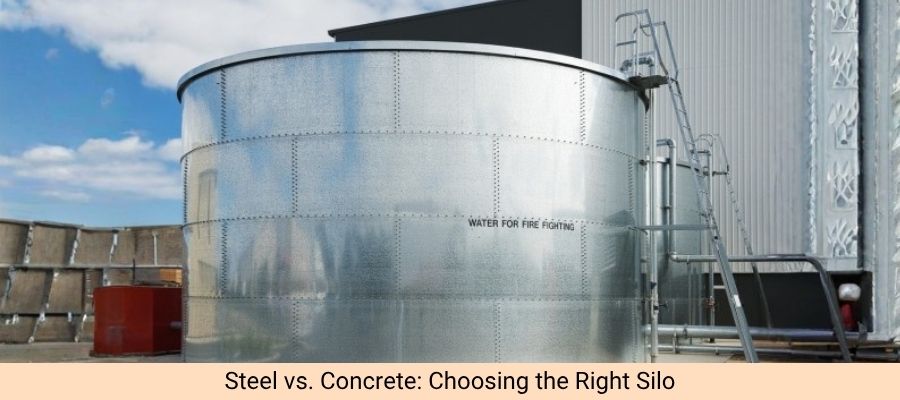Modern Steel Silos & Hoppers : Transforming Grain Storage Efficiency in Uganda

Uganda’s agriculture sector has long been integral to its economy, but challenges related to post-harvest management and grain losses have hampered growth. Traditional storage methods, such as mud and wooden silos, have proven inadequate in addressing these issues, leading to a significant percentage of grains being lost to pests, moisture, and poor ventilation. The introduction of steel silos is revolutionizing grain storage in Uganda by enhancing storage conditions and reducing grain losses, improving food security, and supporting the growth of the agricultural sector.
This article will explore the transformation brought about by steel silos in Uganda’s grain storage system, comparing them with traditional methods, and outlining key considerations for installation and maintenance. We’ll also delve into the environmental and economic benefits, as well as the latest innovations, including steel hoppers and modular designs.
Why Steel Silos Are the Future of Uganda’s Agricultural Storage System
Traditional storage methods in Uganda, such as mud silos and wooden structures, often result in significant post-harvest losses. They are highly vulnerable to pests, weather conditions, and lack proper ventilation, making them less effective at preserving grain quality over time. Steel silos, on the other hand, provide a modern, robust, and efficient solution for grain storage.
Steel silos are increasingly seen as the future of Uganda’s agricultural storage system due to their durability, efficiency, and long-term benefits. Unlike traditional storage methods, steel silos offer better protection against pests, moisture control, and temperature regulation, which significantly reduce grain spoilage and contamination. Steel silos are also highly cost-effective in the long run, requiring less maintenance and offering more capacity for storage.
The long-term benefits of steel silos over traditional methods include:
- Reduced grain losses: Effective sealing and aeration systems protect against pests and spoilage.
- Improved grain quality: Steel silos maintain a consistent environment for grains, ensuring they remain in optimal condition.
- Increased storage capacity: Steel silos can store a large quantity of grain in a compact space, maximizing storage area.
As Uganda’s agriculture sector grows, adopting steel silos will be critical in improving the efficiency of post-harvest management and boosting the nation’s food security.
Key Factors to Consider When Installing Steel Silos & Hoppers in Uganda
Choosing the right design, size, and supplier for steel silos and hoppers is essential for ensuring optimal performance and long-term reliability. In Uganda, several factors need to be considered when installing these systems, including:
- Local Climate and Environmental Conditions: Uganda’s tropical climate can cause high humidity, which may affect grain storage. It is crucial to select silos with aeration and moisture control features to protect against spoilage.
- Storage Capacity: Choose a silo size based on expected grain volumes and future growth projections. Modular designs allow flexibility to expand storage as needs increase.
- Material Quality: Steel silos should be made from corrosion-resistant steel to withstand Uganda’s humid conditions. Suppliers offering galvanized or coated steel should be prioritized.
- Maintenance and Support: Ensure that suppliers offer maintenance services and spare parts to ensure the longevity of the silos and hoppers.
Automation and Technology: Modern steel silos come equipped with automation systems such as aeration control, temperature monitoring, and pest management, all of which increase efficiency.

Steel Silos vs Concrete Silos: Which is Best for Uganda’s Climate and Economy?
When deciding between steel silos and concrete silos for Uganda, both options have distinct advantages and challenges, especially in a tropical climate.
- Durability: Steel silos are generally more resistant to the tropical weather conditions in Uganda compared to concrete silos, which may suffer from cracking or damage due to moisture and humidity. Steel silos have a longer lifespan, especially when coated with corrosion-resistant materials.
- Maintenance: Steel silos require less maintenance compared to concrete silos, which need periodic checks for cracks and moisture-related issues. Concrete silos also tend to be more prone to pest infestations if not properly maintained.
- Cost-Effectiveness: Initially, concrete silos might seem more affordable, but steel silos have lower maintenance costs, are quicker to install, and offer better efficiency over time. In the long run, steel silos prove to be a more cost-effective solution, especially for expanding storage capacity.
In Uganda, where climate conditions and the need for cost-efficient agricultural infrastructure are critical, steel silos are the better option for grain storage, offering a combination of durability, ease of maintenance, and cost-effectiveness.
The Role of Steel Hoppers in Streamlining Feed and Grain Handling Operations
Steel hoppers play a critical role in improving feed and grain handling operations, particularly in agriculture and industrial settings. Steel hoppers provide an efficient, organized flow of materials, reducing labor costs and improving operational efficiency.
Key advantages of steel hoppers include:
- Improved Material Flow: Steel hoppers ensure smooth and controlled movement of grain and feed from silos to processing plants or storage facilities.
- Minimized Spillage: The precise design of steel hoppers prevents material loss during transportation and handling.
- Reduced Downtime: Steel hoppers are designed to handle large volumes, allowing for faster unloading and loading, which reduces downtime and boosts productivity.
- Durability: Steel hoppers are strong and resilient, with corrosion-resistant materials that make them suitable for Uganda’s climate.
In Uganda’s agro-industrial sector, steel hoppers are essential for streamlining operations, improving material handling, and ensuring a consistent supply of quality feed and grain.
How Steel Silos Are Supporting Uganda’s Growing Maize and Coffee Storage Needs
Uganda is a significant producer of maize and coffee, both of which require reliable, efficient storage solutions. Steel silos have become increasingly important in addressing the storage needs of these crops, particularly as Uganda seeks to expand its export capacity.
- Maize Storage: Steel silos provide the perfect environment for storing maize, protecting it from moisture, pests, and contaminants, which can reduce the quality of the grain. This allows Uganda to maintain maize quality for local consumption and export markets.
- Coffee Storage: For coffee, the ability to store beans in a controlled environment is critical for maintaining their flavor and quality. Steel silos equipped with aeration systems and moisture control ensure that coffee beans retain their freshness until they are processed and packaged for export.
Case studies from Uganda’s agricultural sector demonstrate that adopting steel silos has directly contributed to increased productivity and higher quality maize and coffee exports.
Reducing Post-Harvest Losses with Advanced Steel Silo Systems in Uganda
Post-harvest losses are a significant challenge in Uganda, with pests, moisture, and temperature fluctuations causing substantial grain wastage. Advanced steel silo systems are addressing these issues by incorporating aeration, temperature control, and pest prevention technologies.
- Aeration: Steel silos are designed with aeration systems that circulate air within the silo, maintaining a consistent temperature and humidity level to preserve grain quality.
- Pest Control: Modern steel silos are equipped with pest prevention systems, including sealed units and fumigation processes that prevent infestation.
- Temperature Control: Automated systems within the silo regulate temperature to ensure grains are stored in optimal conditions, further reducing spoilage.
These innovations help reduce post-harvest losses, ensuring Uganda’s farmers can maximize the value of their crops.
Sustainable Storage Solutions: Why Ugandan Farmers Are Shifting to Steel Silos
Ugandan farmers are increasingly adopting steel silos due to their eco-friendly and cost-effective benefits. Unlike traditional storage methods, which are often inefficient and prone to damage, steel silos are a sustainable solution that supports both the environment and the economy.
- Eco-Friendly: Steel silos are made from recyclable materials, reducing waste and supporting sustainability in agriculture.
- Energy Efficiency: The aeration and ventilation systems in steel silos ensure that grains are stored in a controlled environment without the need for excessive energy consumption.
- Long-Term Cost Savings: Although the initial investment in steel silos may be higher, the long-term savings in maintenance, grain preservation, and reduced losses make them an economically viable choice for farmers.
Design Innovations in Steel Silos & Hoppers for Uganda’s Agro-Industrial Growth
In recent years, steel silo and hopper designs have undergone significant innovations to meet the demands of Uganda’s agro-industrial sector. Key innovations include:
- Modular Designs: Modular silos allow for flexible expansion, making it easy to increase storage capacity as the demand for grain storage grows.
- Automation: Automation features such as automatic aeration and temperature monitoring have made steel silos more efficient, reducing manual labor and improving grain management.
- Corrosion Resistance: With Uganda’s humid climate, advanced corrosion-resistant coatings are now standard in steel silo designs, ensuring longevity and reducing maintenance costs.
FAQs:
Steel silos offer enhanced durability, reduced post-harvest losses, improved grain quality, and cost-efficiency in the long term.
Steel silos have sealed units and advanced pest control systems, which prevent pest infestations and ensure that grains remain safe during storage.
Consider factors such as aeration systems, moisture control, silo capacity, and supplier reliability when selecting a silo for maize storage.
Yes, steel silos are made from recyclable materials, and their energy-efficient design helps reduce environmental impact.

Founder & CEO
Mukesh Patel is the Founder & CEO of Build Matt ltd, specializing in Pre-Engineered Buildings (PEB) and general steel fabrication. With advanced technology, modern machinery, and a skilled workforce, he delivers efficient and high-quality solutions across East and Central Africa, including Uganda, Kenya, Tanzania, Congo, South Sudan, Rwanda, and Burundi.
- CNC Plasma Cut Decorative Metal Panels: Revolutionizing Interior and Exterior Design
- Combining Roof Vents and Translucent Sheets for Better Airflow and Natural Lighting in Uganda Cities
- Top Design Trends in Steel Staircases for Modern Ugandan Buildings
- Steel Railings & Balustrades for Uganda Cities
- Modern Steel Silos & Hoppers : Transforming Grain Storage Efficiency in Uganda






